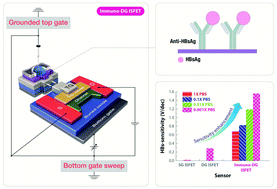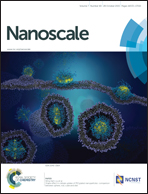A self-amplified transistor immunosensor under dual gate operation: highly sensitive detection of hepatitis B surface antigen†
Abstract
Ion-sensitive field-effect transistors (ISFETs), although they have attracted considerable attention as effective immunosensors, have still not been adopted for practical applications owing to several problems: (1) the poor sensitivity caused by the short Debye screening length in media with high ion concentration, (2) time-consuming preconditioning processes for achieving the highly-diluted media, and (3) the low durability caused by undesirable ions such as sodium chloride in the media. Here, we propose a highly sensitive immunosensor based on a self-amplified transistor under dual gate operation (immuno-DG ISFET) for the detection of hepatitis B surface antigen. To address the challenges in current ISFET-based immunosensors, we have enhanced the sensitivity of an immunosensor by precisely tailoring the nanostructure of the transistor. In the pH sensing test, the immuno-DG ISFET showed superior sensitivity (2085.53 mV per pH) to both standard ISFET under single gate operation (58.88 mV per pH) and DG ISFET with a non-tailored transistor (381.14 mV per pH). Moreover, concerning the detection of hepatitis B surface antigens (HBsAg) using the immuno-DG ISFET, we have successfully detected trace amounts of HBsAg (22.5 fg mL−1) in a non-diluted 1× PBS medium with a high sensitivity of 690 mV. Our results demonstrate that the proposed immuno-DG ISFET can be a biosensor platform for practical use in the diagnosis of various diseases.



 Please wait while we load your content...
Please wait while we load your content...